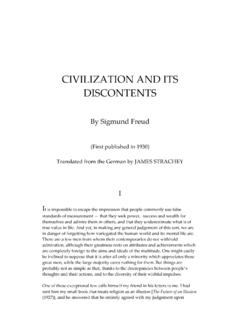Transcription of Explaining Postmodernism - Stephen Hicks
1 Explaining Postmodernism Explaining Postmodernism Skepticism and Socialism from Rousseau to Foucault Expanded Edition Stephen R. C. Hicks Ockham's Razor Publishing first Edition published in 2004 by Scholargy Publishing Expanded Edition published in 2011 by Ockham's Razor Publishing 2004, 2011, 2014 by Stephen R. C. Hicks All rights reserved 14 15 16 9 8 7 6 5 4 3 2 1. Expanded Edition Second Printing Tenth Anniversary Printing Library of Congress Cataloging-in-Publication Data pending Hicks , Stephen R. C., 1960- Explaining Postmodernism : skepticism and socialism from Rousseau to Foucault / Stephen Hicks . p. 276 cm. Includes bibliographic references. Includes index. ISBN: 978-0-9832584-0-7 (cloth). ISBN: (paper). 1. Title. 2. Intellectual History Modern.
2 3. Socialism History. 4. United States Intellectual Life 20th century. 5. Education, Higher Po- litical aspects. 6. Art History Printed in China This book is printed on acid-free paper Contents Thesis: The failure of epistemology made Postmodernism possible, and the failure of socialism made Postmodernism necessary. List of Tables and Charts v Chapter One: What Postmodernism Is The postmodern vanguard 1. Foucault, Lyotard, Derrida, Rorty Modern and postmodern 5. Modernism and the Enlightenment 7. Postmodernism versus the Enlightenment 14. Postmodern academic themes 15. Postmodern cultural themes 18. Why Postmodernism ? 20. Chapter Two: The Counter-Enlightenment Attack on Reason Enlightenment reason, liberalism, and science 23. The beginnings of the Counter-Enlightenment 24.
3 Kant's skeptical conclusion 27. Kant's problematic from empiricism and rationalism 29. Kant's essential argument 32. Identifying Kant's key assumptions 36. Why Kant is the turning point 39. After Kant: reality or reason but not both 42. Metaphysical solutions to Kant: from Hegel to Nietzsche 44. Dialectic and saving religion 46. Hegel's contribution to Postmodernism 50. Epistemological solutions to Kant: irrationalism from Kierkegaard 51. to Nietzsche Summary of irrationalist themes 56. ii Chapter Three: The Twentieth-Century Collapse of Reason Heidegger's synthesis of the Continental tradition 58. Setting aside reason and logic 61. Emotions as revelatory 62. Heidegger and Postmodernism 65. Positivism and Analytic philosophy: from Europe to America 67.
4 From Positivism to Analysis 70. Recasting philosophy's function 72. Perception, concepts, and logic 74. From the collapse of Logical Positivism to Kuhn and Rorty 78. Summary: A vacuum for Postmodernism to fill 79. first thesis: Postmodernism as the end result of Kantian 80. epistemology Chapter Four: The Climate of Collectivism From postmodern epistemology to postmodern politics 84. The argument of the next three chapters 86. Responding to socialism's crisis of theory and evidence 89. Back to Rousseau 91. Rousseau's Counter-Enlightenment 92. Rousseau's collectivism and statism 96. Rousseau and the French Revolution 100. Counter-Enlightenment Politics: Right and Left collectivism 104. Kant on collectivism and war 106. Herder on multicultural relativism 109.
5 Fichte on education as socialization 112. Hegel on worshipping the state 120. From Hegel to the twentieth century 124. Right versus Left collectivism in the twentieth century 125. The Rise of National Socialism: Who are the real socialists? 130. Chapter Five: The Crisis of Socialism Marxism and waiting for Godot 135. Three failed predictions 136. Socialism needs an aristocracy: Lenin, Mao, and the lesson of the 138. German Social Democrats Good news for socialism: depression and war 141. Bad news: liberal capitalism rebounds 143. Worse news: Khrushchev's revelations and Hungary 145. iii Responding to the crisis: change socialism's ethical standard 150. From need to equality 151. From wealth is good to wealth is bad 153. Responding to the crisis: change socialism's epistemology 156.
6 Marcuse and the Frankfurt School: Marx plus Freud, or 159. oppression plus repression The rise and fall of Left terrorism 166. From the collapse of the New Left to Postmodernism 170. Chapter Six: Postmodern Strategy Connecting epistemology to politics 174. Masks and rhetoric in language 175. When theory clashes with fact 178. Kierkegaardian Postmodernism 179. Reversing Thrasymachus 182. Using contradictory discourses as a political strategy 184. Machiavellian Postmodernism 186. Machiavellian rhetorical discourses 187. Deconstruction as an educational strategy 188. Ressentiment Postmodernism 191. Nietzschean ressentiment 192. Foucault and Derrida on the end of man 195. Ressentiment strategy 198. Post- Postmodernism 201. Bibliography 202. Index 212.
7 Acknowledgements 223. Two Additional Essays Free Speech and Postmodernism Sample speech codes 225. Why not rely on the first amendment ? 226. Context: why the Left? 227. Affirmative action as a working example 228. Egalitarianism 231. Inequalities along racial and sexual lines 233. The social construction of minds 234. Speakers and censors 236. iv The heart of the debate 238. The justification of freedom of speech 239. Three special cases 241. Racial and sexual hate speech 242. The university as a special case 243. From Modern to Postmodern Art: Why Art Became Ugly Introduction: the death of modernism 247. Modernism's themes 248. Postmodernism 's four themes 257. The future of art 263. **. v List of Tables and Charts Chart : Defining Pre-modernism and Modernism 8.
8 Chart : The Enlightenment Vision 13. Chart : Defining Pre-modernism, Modernism, and 15. Postmodernism Chart : Marxism on the Logic of Capitalism 138. Chart : Total Livestock in the Soviet Union 144. Chart : Gross Physical Output for Selected Food Items 145. Chart : Deaths from Democide Compared to Deaths from 148. International War, 1900-1987. Chart : Left Terrorist Groups' Founding Dates 168. Chart : The Evolution of Socialist Strategies 173. **. Chapter One What Postmodernism Is The postmodern vanguard By most accounts we have entered a new intellectual age. We are postmodern now. Leading intellectuals tell us that mod- ernism has died, and that a revolutionary era is upon us an era liberated from the oppressive strictures of the past, but at the same time disquieted by its expectations for the future.
9 Even Postmodernism 's opponents, surveying the intellectual scene and not liking what they see, acknowledge a new cut- ting edge. In the intellectual world, there has been a changing of the guard. The names of the postmodern vanguard are now familiar: Michel Foucault, Jacques Derrida, Jean-Fran ois Lyotard, and Richard Rorty. They are its leading strategists. They set the direction of the movement and provide it with its most potent tools. The vanguard is aided by other familiar and often in- famous names: Stanley Fish and Frank Lentricchia in literary and legal criticism, Catharine MacKinnon and Andrea Dwor- kin in feminist legal criticism, Jacques Lacan in psychology, Robert Venturi and Andreas Huyssen in architectural criti- cism, and Luce Irigaray in the criticism of science.
10 Members of this elite group set the direction and tone for the postmodern intellectual world. 2 Explaining Postmodernism Michel Foucault has identified the major targets: All my analyses are against the idea of universal necessities in hu- man existence. 1 Such necessities must be swept aside as bag- gage from the past: It is meaningless to speak in the name of or against Reason, Truth, or Knowledge. 2. Richard Rorty has elaborated on that theme, Explaining that that is not to say that Postmodernism is true or that it of- fers knowledge. Such assertions would be self-contradictory, so post-modernists must use language ironically.. The difficulty faced by a philosopher who, like my- self, is sympathetic to this suggestion [ , Fou- cault's] one who thinks of himself as auxiliary to the poet rather than to the physicist is to avoid hint- ing that this suggestion gets something right, that my sort of philosophy corresponds to the way things re- ally are.






